The other day I received a question about how to combine bodyweight and oldtime strongman training. Since I hadn’t specifically covered that topic before I thought it was worth doing an in-depth article on it.
I guess that makes this the third article in a series. The first one was a big article about a big subject, how to combine weights and bodyweight training. The second part specifically addressed combining kettlebells with bodyweight exercise.
I would recommend you read both of those, especially the first one, as it will lay some of the foundation for this article.
Bodyweight training is fairly clear. It is any form of training that uses your own bodyweight as the resistance. Of course this then means it covers a huge amount of ground from calisthenics to more advanced forms of gymnastics, breaking dancing, hand balancing, rope climbing and all sorts of other specialties.
But what is meant by Oldtime Strongman Training?
How is this different then other forms of lifting? If we don’t properly define this term it makes this article tough to write. The Oldtime Strongman as a whole had a wide range of training, just like people today. Some did mostly bodyweight stuff. Lots of them lifted weights of various sorts. Most of them did some type of performing and/or competitions.
To separate out oldtime strongman training from weightlifting, that is with barbells and dumbbells and other forms of training, I think there are really two main categories that don‘t fit into most other forms of training.
1. Partials and Supports
2. Grip Centered Feats
1) Partials and Supports
Although people lift some big weights these days its almost always done in a “full range of motion”. (I put that in quotes because its not actually true. A deadlift is from how high the plates make the bar. A squat to parallel isn’t full range either.)
A common practice of oldtime strongman was various support feats. The power rack wasn’t invented back in their hey day so they weren’t as common, but there are other methods of setting these up. While there are differences between partials and supports, these two forms of lifting have one thing in common. You can handle some massive weights!
And these aren’t often done these days. In fact most people scoff at something like a rack pull because they have no frame of reference for it, or the power it can build.
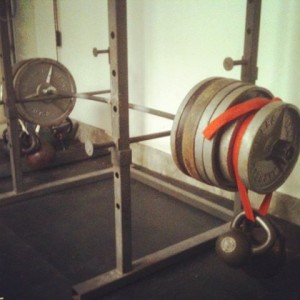
Heavy short range movements are a good oldtime strongman method to build crazy strength.
There’s also some special moves like the bent press or getup that are really moving supports. That may sound like an oxymoron. But what I mean by that is you’re moving around the weight while it is supported. In the getup the arm stays locked out as your body gets up. In the bent press you fold under the weight while the arm supports it, before standing up with it overhead.
So this is one grouping that I would put under oldtime strongman training. The focus of this sort of training is more on the tendons, ligaments and bones then just the muscles.
2) Grip Centered Feats
Then you have some of the classic feats of strength like bending nails, phonebook and card tearing. Many, but not all feats of strength, are centered around the grip. For a large part hand strength is a forgotten component of training today. Yet this was a major focus of the oldtime strongmen.
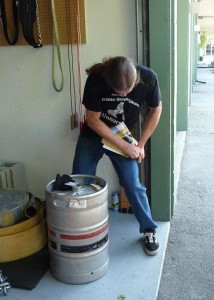
Many of the oldtime feats use the whole body but are centered around the hands like phonebook tearing.
Even if it wasn’t destroying objects you have many other forms of grip centered lifting like thick barbells, anvil lifting, finger lifting and more.
Make sure to review the Feats of Strength Index for more info on all these feats and more.
Here too you’ll see the focus on the tendons and ligaments of the hands and forearms, simply because there isn’t that much muscular tissue in this area.
So these two categories are how I’d define Oldtime Strongman Training, at least as far as exercises are concerned. You could also define it in structure or philosophy but that‘s a whole other subject.
Big Basic Movements
As mentioned previously for any beginning trainee it is wise to focus on the major movement patterns of the human body which includes:
- Upper Body Push
- Upper Body Pull
- Lower Body Push
- Lower Body Pull
If you cover those four categories of movement you’ve covered the majority of the body. And those can be covered with weights, bodyweight or any number of other tools.
The support and partials can fall into these categories as well. An overhead support is similar to a press or upper body push. A rack pull is similar to a deadlift or lower body pull. And of course there are many other options.
While you can just focus on short range partials or supports, for overall strength it is important to do full ranges of movement. So a mix and match of these is usually best. Of course, temporary focus on just one thing can be a great way for fast gains before moving onto something else.
These movements can be grip centered as in using thick barbells or dumbbells. The important issue to pay attention to here is will you just be training your grip, because its limiting your movements due to it being the weak link?
Skill Training and Technique
There is technique and skill behind any movement. This is especially true as you move onto more advanced moves.
Pushups, squats and deadlifts all take technique but its nothing compared to a freestanding handstand pushup, muscle up, tearing a phonebook or a bent press.
Thus, depending on what you’re working on, you may want to alter your training to be more technique or skill based practice and less of a “workout”.
This is true of bodyweight training. As you get stronger you soon need to move into more skill based training in order to continue to progress.
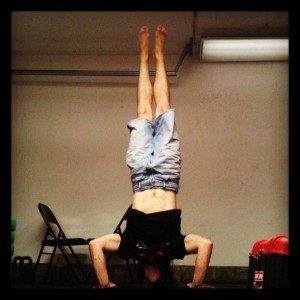
Freestanding handstand pushups take skill and strength.
With oldtime strongman training it depends. With supports and partials, these are very low technique movements. That’s part of why they can actually be very safe and can be trained hard.
With some of the feats of strength, lots of technique is needed. Sure you can handle lots of weight in the bent press, once your technique is spot on, but not before. The first time you try it you’ll probably do less than you can military press, but once good you can do significantly more.
For any skill based or technique training this is best done when you’re fresh and not fatigued. So its great to do it at the start of your workouts or even a separate session altogether.
Programming and Workout Ideas
These are all broad strokes. How one person combines bodyweight training with oldtime strongman will look very different than another, based on what they’re working on and where they’re at. So this section is meant to offer some ideas that you can play with to find what works for you. If you’re looking for a step by step program that would require an individual consultation.
1 – Alternate Days
Let’s say you workout three times a week. You can do the old AB split. On week one you do the A workout on Monday and Friday. On Wednesday you do the B workout. The next week it switches so B is Monday and Friday and A on Wednesday.
And here instead of splitting your body up into parts like a bodybuilder does you do bodyweight exercise one day and oldtime strongman training the next.
2 – Mixed Exercises
Train both on the same day. You can easily switch from one exercise to the next. Here’s just one example of what that could look like combining bodyweight with weights and strongman training.
Workout 1
Work on the Getup
Alternate Pullups with Rack Pulls
Alternate Handstand Pushups with Squat Support
Work on Phonebook Tearing
Conditioning with Kettlebell Juggling
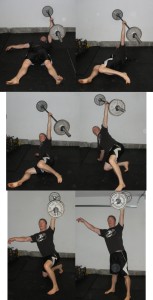
The getup with a barbell is a phenomenal exercise. Tons of strength and balance needed.
Workout 2
Work on the Getup
Alternate Deadlifts with Overhead Support
Alternate Pistols with Weighted Chinnups
Work on Bending Steel
Conditioning with Hill Sprints
These two workouts could be quite intense but you’re covering lots of ground with them. This would probably work well for a two workouts per week schedule.
3 – Skill Before
This has already been mentioned. And you could see a little bit of it in the previous example with the getup. The idea here is if you’re working on technique, whether this is a bodyweight exercise, or a feat of strength, just insert this before your other workout, or do it separately. While there is a strength component more or less to all of these, training them as a skill is much more necessary. Here’s a few examples:
- Hand Balancing
- Driving Nails through Boards
- Muscle Control
- Phonebook or Card Tearing
- Trickier Supports (like the Wrestling Bridge Support)
- Two Hands Anyhow
- Getup
Not only can you train the skill but these can then also act as a warmup to the rest of your training.
4 – Intensive
For those times you want to bomb and blast yourself, like with a challenge workout, why don’t you just put it all together. This can go from the more skilled to the more brute force. For instance:
Leg Intensive
Pistols
Front Squats
Back Squats
Partial Squats
Pressing Intensive
Handstand Pushups
Kettlebell Press
Partial Press
Overhead Support
As you go through your training you’ll come to learn lots of things that work for you. For instance I have found that bending steel, in any form, because of the intensive wrist work, doesn’t combine too well with hand balancing, at least for me. Its just too much overall wrist work. I can’t properly recover from intensive bending with daily hand balancing practice. So when I’m working intently on one I skip the other.
Comments? Questions? Suggestion? Reply below…
For more detailed training and techniques check out the following courses: Deceptive Strength, Feats of Strength, Strengthen Your Structure, and the Ultimate Guide to Bodyweight Training Series.

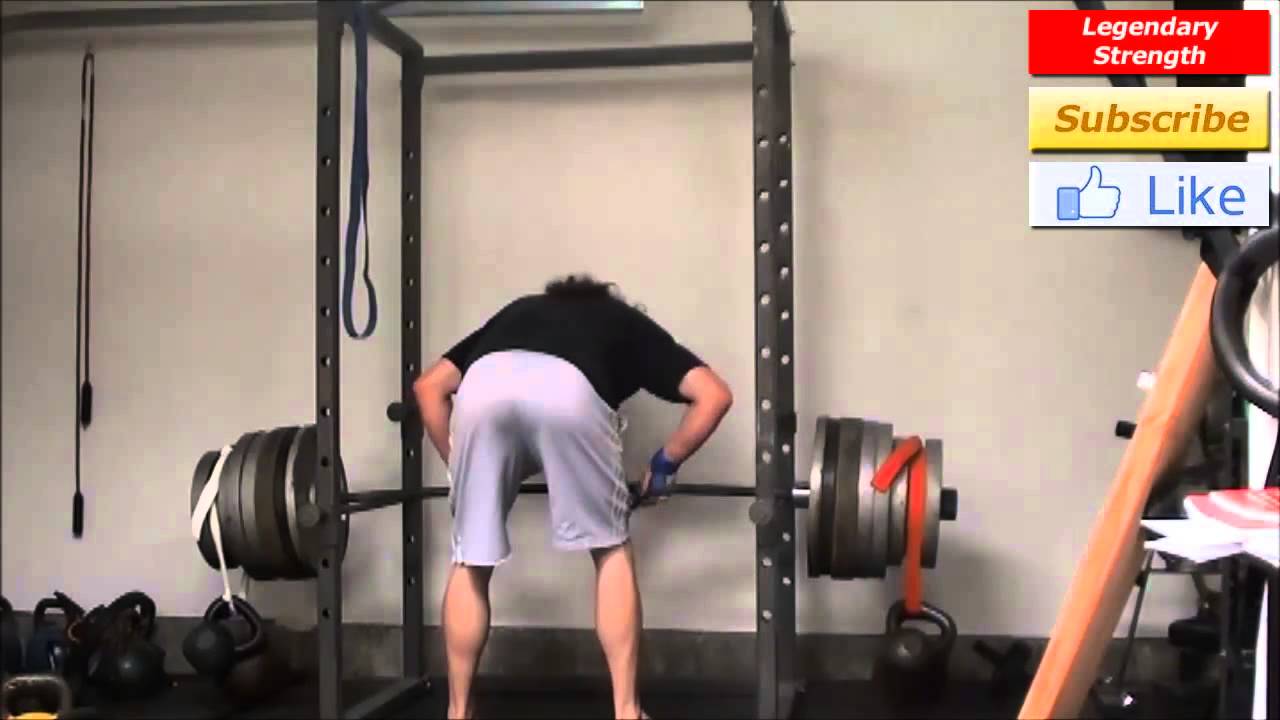
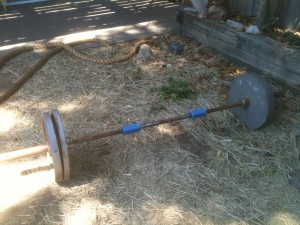
Comments
Logan
What are your thoughts on alternating 2 week cycles, one progressive calisthenics, and one weighted? I recall such programing from the book “Easy Strength” but they were talking about alternating between kettlebell and barbell exercises. According to that text, strength gains can be maintained for about a month and conditioning gains can be maintained for 2 weeks. Thus is seems to me that one could alternate between weighted and unweight movements in two week cycles.
Yes, that would definitely work.
Thanks
If I had an intense upper body workout,later on could I practice my bodyweight skill movements the same day instead of doing it in the workout?
It really depends on intensity, volume, duration and such of both the workouts and the skill practice. So the answer is maybe. Do it and see if you make progress in both. If it works keep doing it. If it doesn’t work you’ll need to alter your plan.